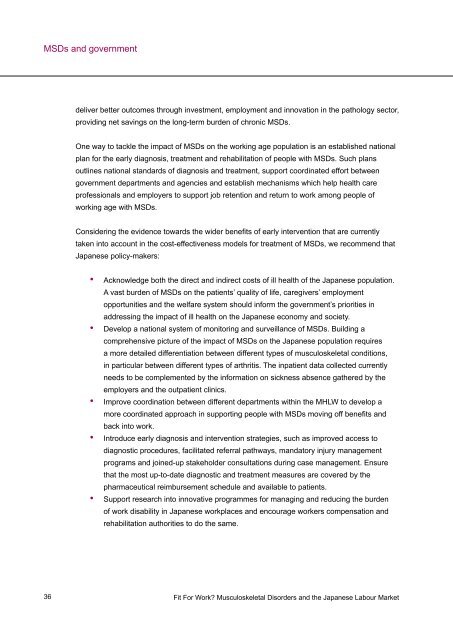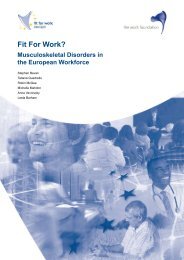English version - Fit for Work Europe
English version - Fit for Work Europe
English version - Fit for Work Europe
Create successful ePaper yourself
Turn your PDF publications into a flip-book with our unique Google optimized e-Paper software.
MSDs and government<br />
36<br />
deliver better outcomes through investment, employment and innovation in the pathology sector,<br />
providing net savings on the long-term burden of chronic MSDs.<br />
One way to tackle the impact of MSDs on the working age population is an established national<br />
plan <strong>for</strong> the early diagnosis, treatment and rehabilitation of people with MSDs. Such plans<br />
outlines national standards of diagnosis and treatment, support coordinated ef<strong>for</strong>t between<br />
government departments and agencies and establish mechanisms which help health care<br />
professionals and employers to support job retention and return to work among people of<br />
working age with MSDs.<br />
Considering the evidence towards the wider benefits of early intervention that are currently<br />
taken into account in the cost-effectiveness models <strong>for</strong> treatment of MSDs, we recommend that<br />
Japanese policy-makers:<br />
• Acknowledge both the direct and indirect costs of ill health of the Japanese population.<br />
A vast burden of MSDs on the patients’ quality of life, caregivers’ employment<br />
opportunities and the welfare system should in<strong>for</strong>m the government’s priorities in<br />
addressing the impact of ill health on the Japanese economy and society.<br />
• Develop a national system of monitoring and surveillance of MSDs. Building a<br />
comprehensive picture of the impact of MSDs on the Japanese population requires<br />
a more detailed differentiation between different types of musculoskeletal conditions,<br />
in particular between different types of arthritis. The inpatient data collected currently<br />
needs to be complemented by the in<strong>for</strong>mation on sickness absence gathered by the<br />
employers and the outpatient clinics.<br />
• Improve coordination between different departments within the MHLW to develop a<br />
more coordinated approach in supporting people with MSDs moving off benefits and<br />
back into work.<br />
• Introduce early diagnosis and intervention strategies, such as improved access to<br />
diagnostic procedures, facilitated referral pathways, mandatory injury management<br />
programs and joined-up stakeholder consultations during case management. Ensure<br />
that the most up-to-date diagnostic and treatment measures are covered by the<br />
pharmaceutical reimbursement schedule and available to patients.<br />
• Support research into innovative programmes <strong>for</strong> managing and reducing the burden<br />
of work disability in Japanese workplaces and encourage workers compensation and<br />
rehabilitation authorities to do the same.<br />
<strong>Fit</strong> For <strong>Work</strong>? Musculoskeletal Disorders and the Japanese Labour Market







